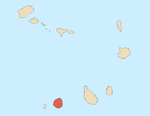Fogo Natural Park
Fogo Natural Park (Portuguese: Parque Natural do Fogo), on the island of Fogo, is one of ten "natural parks" in the country of Cape Verde. The protected area is 84.69 km (32.70 sq mi), which is 17.8% of the total area of the island. 50% of the park lies within the municipality Santa Catarina do Fogo, 28% in municipality of Mosteiros and 22% in São Filipe. The natural park is situated in the interior of the island, and covers the volcano Pico do Fogo, its crater and crater rim (Bordeira) and the forest of Monte Velha. The volcano is active; the most recent eruption was in 2014-15.
Flora and fauna
The volcano area of Fogo is an Important Bird Area. Key bird species are Fea's petrel, Boyd's shearwater and Cape Verde swift. The ocean around the island of Fogo is another Important Bird Area covering 2,473 km (955 sq mi).
The endemic plants Echium vulcanorum (endangered) and Erysimum caboverdeanum (critically endangered) are only found on the outer crater rim of the volcano of Fogo.
References
- ^ Parques Naturais, Áreas protegidas Cabo Verde
- ^ Resolução nº 36/2016 Archived 2021-01-18 at the Wayback Machine, Estratégia e Plano Nacional de Negócios das Áreas Protegidas
- ^ Estatísticas do Ambiente - 2016, Instituto Nacional de Estatística, p. 24
- ^ Eruptive history of Mount Fogo at the Smithsonian Global Volcanism Program
- ^ "Volcano area, Ilha do Fogo". Important Bird Areas factsheet. BirdLife International. 2018. Retrieved 2018-08-07.
- ^ "Volcano area, Ilha do Fogo - Marine". Important Bird Areas factsheet. BirdLife International. 2018. Retrieved 2018-08-07.
- ^ Catarino, S.; Duarte, M.C.; Romeiras, M.M. (2017). "Echium vulcanorum". IUCN Red List of Threatened Species. 2017: e.T107425957A107468177. doi:10.2305/IUCN.UK.2017-3.RLTS.T107425957A107468177.en. Retrieved 6 January 2020.
- ^ Catarino, S.; Duarte, M.C.; Romeiras, M.M. (2017). "Erysimum caboverdeanum". IUCN Red List of Threatened Species. 2017: e.T107426112A107468187. doi:10.2305/IUCN.UK.2017-3.RLTS.T107426112A107468187.en. Retrieved 12 November 2021.
